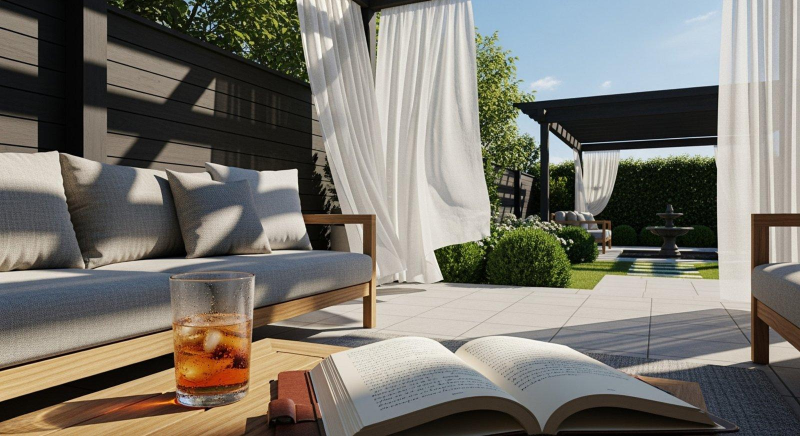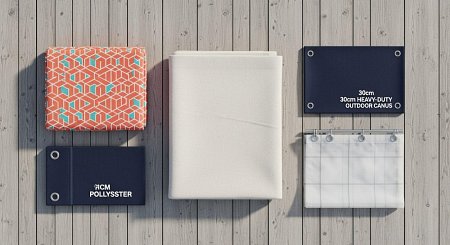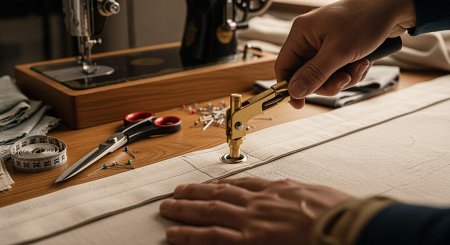
The great thing about DIY is that you can save a lot of money and get exactly the style you want. While store-bought outdoor curtains, such as those from Pottery Barn, cost around $59 to $79 for a single panel, making them yourself can often bring the total cost under $50 for your entire gazebo. You get to choose the materials, colors, and designs that fit your taste and your outdoor needs.
If you need more inspiration or want to see custom solutions, look at these outdoor pergola curtains for ideas that can also guide your DIY decisions.
Why Install DIY Outdoor Pergola Curtains?
DIY outdoor pergola curtains are useful for more than just looks. They help solve practical problems and can make your outdoor space more enjoyable. By providing comfort, privacy, and a fresh look, curtains can make a big difference to your home’s exterior.
Imagine sitting on your patio, feeling a soft breeze, but without the sunlight shining directly on you or outsiders looking in. Curtains can do that, turning your outdoor area into a comfortable space that feels more like an extra room than just an open backyard.
Main Benefits: Comfort, Privacy, and Shade
The biggest advantages of outdoor curtains are comfort and privacy. They offer much-needed shade if your outdoor area gets a lot of sun, keeping you cool and protecting your outdoor furniture from fading. Curtains also work as a privacy shield, perfect if you have close neighbors or just want to relax without others seeing in. This makes your patio feel cozy-even a little like a fancy cabana.
Outdoor curtains can also help on windy days, lowering breezes and keeping your space calmer. While they aren’t a replacement for walls during storms, they do block mild gusts and may help keep some bugs out. You can open or close the curtains as needed, giving you full control over your comfort.
How Curtains Change Your Outdoor Style and Value
Adding DIY outdoor curtains instantly makes your pergola or patio look more finished. The soft fabric brings warmth and character to your yard, making it feel more welcoming. Curtains can bring color, soften sharp edges, and help divide up large spaces, such as creating a special eating or sitting area. Even simple white panels will make your patio feel brighter and more stylish.
A nice outdoor area also adds value to your home. If potential buyers see a property with a clean, functional, and pretty backyard, they often see it as a bonus. DIY curtains are a small investment with a big payoff since they can improve how your home looks and feels. Plus, it’s easy to swap out new panels for a fresh look whenever you want.
What Should You Think About Before Starting a DIY Curtain Project?
Before you start measuring or buying fabric, a little planning is important. Taking the time to consider details and make careful choices can help you avoid mistakes and get curtains that fit well and last longer.
From getting your measurements right to picking the right fabric for your weather, every choice will affect how your curtains look and function. Here’s what you should think through before getting started:
Measuring and Sizing for the Right Fit
Correct measurements are key. Measure from the ground to where you’ll hang the curtains-usually the middle of the top beam of your pergola. Check measurements at different points, since outdoor structures aren’t always perfectly level. Don’t forget to add extra length for hemming-usually about 4 extra inches (2 inches for the top and 2 for the bottom).
For the width, decide if you want your curtains to close completely or just hang at the sides. If you want them to close, make sure your fabric panels are wide enough for a full, draped look.
Using materials like bedsheets or drop cloths can sometimes limit your width, so plan how many panels you’ll need. Think about tie-backs or how the curtains will gather, which might change the width you actually need.
Choosing Materials That Hold Up Outdoors
Outdoor fabrics need to handle sun, rain, and wind. Outdoor-specific fabrics are available, but they can be expensive. Many people use cotton sheets, painter’s drop cloths, or similar affordable options. To make these last longer, use waterproofing spray (it’s not permanent but helps). Keep in mind that cotton can get moldy in humid places and may fade. Polyester or synthetic fabrics are usually better because they’re more resistant to fading and mildew and dry faster. They’re also light, which makes them easier to hang but can blow around more in the wind.
Don’t forget to consider what you’ll use to hang the curtains. Pick rust-proof hardware, like galvanized pipes for rods or coated metal weights for the hem. If it’s very windy, sew washers or other weights into the bottom hem to stop the curtains from flapping.
Budgeting for a Low-Cost Project
DIY outdoor curtains are often cheaper than buying ready-made panels, but it’s smart to plan your spending. Most fabric stores offer cotton options by the yard, bedsheets for as low as $5 each, or drop cloths at an even lower cost. If you need many panels, prices can add up, so comparing prices on all materials is a good idea.
Don’t forget to add up all the extras you need: grommets, hooks, rods, tie-backs, and maybe waterproofing spray. Even small things like hardware can add up. Using things you already have, like old sheets, saves even more money. With careful planning, you can get a big update on a small budget.
Best Cheap Materials for Outdoor Pergola Curtains
The secret to saving money on outdoor pergola curtains is picking the right materials. You don’t have to buy expensive outdoor fabric; there are several cheap options that still look great and hold up outside.
Here’s a list of easy-to-find materials you can use:
| Material | Pros | Cons | Best Use |
| Drop Cloths | Cheap, sturdy, provides privacy | Holds water, can mildew, may stain | Solid curtains, rustic look |
| Bedsheets (esp. Polyester) | Inexpensive, lots of designs, resists mildew | Lighter weight, can blow in wind | Patterned or colorful panels |
| Outdoor Canvas | Made for outdoors, long-lasting | More expensive, stiff | Heavy-duty, long-term use |
| Synthetic Fabrics | Fade and mildew-resistant, dries fast | Light, might flap more | Quick-dry panels, easy to hang |
| Bamboo Blinds | Eco-friendly, unique look | Needs to be rolled up in wind | Small patios, rustic spaces |
| Shower Curtains | Water-resistant, easy to clean | Limited style choices | Decorative & functional panels |

Drop Cloths: Sturdy and Budget-Friendly
Drop cloths are a favorite for DIYers. They’re strong, cheap, and easy to find at hardware stores. They offer good sun protection and a simple look that fits most outdoor styles. Wash them before use to soften them and add waterproofing spray for more durability outdoors. Just beware-they can get heavy after it rains and may need more washing in humid areas.
Outdoor Canvas and Synthetic Fabrics
If your budget is a bit bigger, look for outdoor canvas, which is designed to last outside but can be stiff and pricey. Synthetics like polyester or olefin are strong, resist fading, and dry quickly. They’re often used for store-bought patio curtains. Lightweight synthetics can flap in the wind, but this can be fixed by adding weights.
Bamboo, Recyclable, and Other Options
If you want something different or more sustainable, consider bamboo roll-up shades or recycled materials. Old bed sheets (especially if they’re mostly polyester) or even shower curtains can be used, offering lots of design and color choices. Just make sure the material is practical for your climate and secure them well so they don’t blow away or get damaged.
How to Install DIY Pergola Curtains Step-by-Step
With your materials and measurements ready, you’re set to start. Even if this is your first DIY project, you can complete it if you follow each step calmly.
Here’s a step-by-step guide to installing your new pergola curtains:
What You’ll Need
- Fabric: Drop cloths, bedsheets, canvas, or synthetic panels
- Measuring Tape
- Fabric Scissors
- Sewing Machine or Fabric Glue/Hemming Tape
- Iron & Ironing Board
- Grommet Kit (grommets and tool)
- Pencil or Fabric Marker
- Drill & Drill Bits
- Cup Hooks or other Hanging Hardware
- Tie-back material: Rope, chain, or fabric strips
- Cutters (for chain or rope)
- Waterproofing Spray (optional)
- Weights: Lead weights, washers, or similar
- Curtain Clips, S Hooks (if using a rod)
- Wood pieces and paint (if extra support needed)

Getting the Panels Ready
- Wash and dry your chosen fabric (air dry to avoid shrinking cotton).
- Iron out wrinkles, then cut fabric to your measured size, adding extra for hems.
- Double-fold the edges (especially top and bottom), iron flat, and sew them for a clean look.
- If you want to weigh the panels down, slip washers or weights into the bottom hem before sewing it shut.
- Mark where your grommets will go on the top edge. Space them evenly and insert the grommets according to your kit’s instructions.
Mounting Curtains: Hanging Methods
- Cup Hooks & Grommets: Measure out from the pergola posts and mark where the hooks should go. Drill pilot holes, then screw in the hooks. Hang the curtains by feeding the grommets onto the hooks.
- DIY Rods: Use galvanized pipe or conduit as a cheap and strong curtain rod. Thread the curtains on directly, or use clips with S hooks.
- Direct Fasten: If your pergola structure allows, staple curtains directly to the beam for a setup that won’t be moved much.
Securing Curtains for Wind and Rain
- Add weights to the hem or use tie-backs to stop the curtains from blowing everywhere.
- Screw additional hooks or anchors where you want tie-backs. Rope, fabric, or even linked chain can be used.
- Spray waterproofing on both sides of the fabric and let dry. This will help with rain and mildew resistance.
- If very bad weather is expected, remove the curtains to avoid damage and extend their lifespan.
Care and Cleaning Tips
- Shake out dust and debris regularly.
- Machine wash on gentle (if possible), air dry to avoid shrinking.
- Clean any stains or mildew with a diluted bleach solution or fabric cleaner-test first to avoid damage.
- Reapply waterproof spray every season or after heavy cleaning.
- Store curtains dry and clean during winter or storms to keep them looking good longer.
- Check hardware for rust and replace as needed to keep everything safe and secure.
Ways to Personalize Your Outdoor Curtains
DIY projects let you add your own touch. Once the basic curtains are up, you can make them stand out even more by adding unique details. Here are a few ways to customize your outdoor curtains:
- Decorative Tie-Backs: Instead of plain rope, use strips of different fabric, braided jute, or even bands in a contrasting color.
- Add Bands or Edging: Sew colorful or patterned fabric along the edge for a stylish look and a bit more weight.
- Painting and Stenciling: Use outdoor paint to add stripes, patterns, or art to your curtains. Stencils are an easy way to apply repeating shapes or borders.
- Accessories: Hang string lights around the pergola, drape fairy lights along the curtain rod, or add weatherproof tassels for extra flair. Coordinate pillows and throws with your curtain colors.
- Plants and Decor: Add potted plants, lanterns, or small sculptures nearby to finish the space.
Inspiration: Real Outdoor Curtain Projects that Make a Big Change
Plenty of people have improved their patios and backyards with cheap curtain makeovers. These ideas show what’s possible, even with a small budget.
Before and After: Curtain Makeovers
Take a bare pergola or a patio that feels too open-and look at the difference after adding simple curtains. A few bedsheets or drop cloths hung with homemade rods can turn an exposed area into an inviting retreat with shade and privacy. The curtains often make the biggest impact for the least amount of money.
Budget-Friendly Success Stories
Many DIYers find they can update their entire outdoor area for less than $50 by using drop cloths or polyester sheets. By adding a band of different fabric or just clipping them up with curtain rings, you can create a designer look.
Quick upgrades like this make hot or exposed patios comfortable again, block the view of neighbors, and look much more polished than before. The idea remains the same-creative thinking and hands-on work give the best results for the lowest cost.
Common Questions About DIY Outdoor Pergola Curtains
DIY projects often come with questions. Here are answers to the most common ones about outdoor pergola curtains:
Should You Use Drop Cloths, Sheets, or Outdoor Fabric?
Pick based on your budget, weather, and style. Drop cloths are sturdy and cost-effective, but they may hold water and get musty. Polyester sheets are cheaper, resist mildew and fading, and come in many colors and patterns. Outdoor fabric lasts the longest but costs the most. A lot of people choose drop cloths or polyester sheets with waterproofing spray because they get good results for a low price.
How Do You Keep Curtains Looking Good?
Shake out dust, wash when needed, and don’t let stains build up. Use waterproofing spray each season and store the curtains during winter or storms. If mold appears, treat with diluted bleach or cleaner. Regular cleaning and good care make them last longer and look cleaner.
Are They Safe and Weather Resistant?
DIY curtains aren’t totally storm-proof, but they handle normal outdoor use if you add weather protection and secure them properly. For heavy rain or wind, take the curtains down or tie them back tightly to protect them and avoid damage to the pergola. Some people use a second rod or attach the bottoms as well during storms. Watch the weather forecast and act early if bad conditions are coming.
